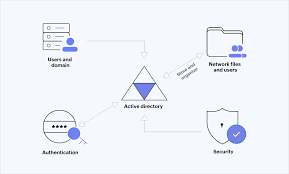The Importance of Active Directory in Modern IT Environments
Active Directory is a crucial component in the realm of IT infrastructure for organisations worldwide. It serves as a centralised database that stores and manages information about network resources, making it easier to organise, manage, and secure a network.
One of the key advantages of Active Directory is its ability to provide a single sign-on experience for users within a network. This means that users only need one set of credentials to access various resources, simplifying the authentication process and enhancing security by reducing the risk of password fatigue or weak passwords.
Furthermore, Active Directory enables administrators to implement group policies that define user permissions and access rights. This granular control ensures that sensitive data remains secure and only accessible to authorised individuals, thereby reducing the risk of data breaches.
Another significant benefit of Active Directory is its support for scalability. As organisations grow and evolve, Active Directory can easily accommodate changes in user accounts, groups, and resources without compromising performance or security.
In addition to enhancing security and streamlining user management, Active Directory plays a vital role in facilitating collaboration and productivity within an organisation. By providing a unified directory service, it enables seamless communication and resource sharing among employees, fostering teamwork and efficiency.
In conclusion, Active Directory is an indispensable tool for modern IT environments. Its robust features not only enhance security and streamline user management but also promote collaboration and productivity within organisations. By leveraging the power of Active Directory, businesses can create a secure, efficient, and interconnected network environment that supports their growth and success.
Mastering Active Directory: A Comprehensive Guide to Configuration, Management, and Security
- What is Active Directory and how does it work?
- What are the benefits of using Active Directory in an organisation?
- How can I set up and configure Active Directory for my network?
- What are group policies in Active Directory, and how do they work?
- How do I manage user accounts and permissions in Active Directory?
- What security measures should I implement to protect my Active Directory environment?
- Can I integrate third-party applications with Active Directory, and if so, how?
- What are the common challenges faced when maintaining an Active Directory infrastructure?
What is Active Directory and how does it work?
Active Directory is a crucial component in modern IT infrastructure, serving as a centralised database that stores information about network resources such as computers, users, and groups. It works by providing a hierarchical structure that organises these resources into a logical framework, making it easier for administrators to manage and secure the network. Active Directory uses a domain-based model where each domain represents a security boundary within the network, allowing administrators to set permissions and access controls based on user roles and group memberships. Through its domain controllers, Active Directory authenticates and authorises users to access resources, ensuring secure and efficient communication within the network environment.
What are the benefits of using Active Directory in an organisation?
Implementing Active Directory in an organisation offers a multitude of benefits that enhance efficiency, security, and collaboration. One key advantage is the centralised management of user accounts and resources, simplifying administrative tasks and ensuring consistent access control. Active Directory’s support for group policies allows for granular control over user permissions, reducing the risk of data breaches and ensuring compliance with security standards. Additionally, the scalability of Active Directory enables seamless expansion as the organisation grows, maintaining performance and security. By providing a unified directory service, Active Directory promotes collaboration among employees, streamlines communication, and boosts overall productivity within the organisation.
How can I set up and configure Active Directory for my network?
Setting up and configuring Active Directory for your network is a fundamental step in establishing a secure and efficient IT environment. To begin, you need to install the Active Directory Domain Services role on a Windows Server. Once installed, you can use the Active Directory Domain Services Configuration Wizard to promote the server to a domain controller. During this process, you will need to specify the domain name, set a Directory Services Restore Mode password, and choose whether to install DNS on the same server. After promoting the server to a domain controller, you can start creating user accounts, groups, organisational units, and defining group policies to manage access and permissions within your network. Regular monitoring and maintenance of Active Directory are essential to ensure its optimal performance and security for your network infrastructure.
What are group policies in Active Directory, and how do they work?
Group policies in Active Directory are a powerful tool used to manage and enforce specific settings and configurations across a network of computers. Essentially, group policies define rules that dictate how users and computers interact with the network and what they can do. These policies can control various aspects such as security settings, desktop configurations, software installation, and more. When a user logs into a computer that is part of an Active Directory domain, the group policies assigned to that user or computer are applied, ensuring consistency and standardisation across the network. Group policies work by creating a hierarchical structure where policies at different levels can be inherited or overridden based on their priority, allowing administrators to customise settings based on organisational requirements.
How do I manage user accounts and permissions in Active Directory?
Managing user accounts and permissions in Active Directory is a fundamental task for IT administrators seeking to maintain a secure and organised network environment. To manage user accounts, administrators can create, modify, or delete user accounts through the Active Directory Users and Computers console. This tool allows for the assignment of specific permissions to users based on their roles within the organisation. By defining access rights and group memberships, administrators can control what resources users can interact with, ensuring data security and compliance with organisational policies. Regularly reviewing and updating user permissions is essential to maintaining a robust security posture and preventing unauthorised access to sensitive information within the Active Directory environment.
What security measures should I implement to protect my Active Directory environment?
When considering security measures to safeguard your Active Directory environment, it is crucial to implement a multi-layered approach that addresses various aspects of security. Firstly, enforcing strong password policies and implementing multi-factor authentication can significantly enhance the authentication process and prevent unauthorised access. Regularly updating and patching systems to address vulnerabilities is essential in mitigating potential security risks. Additionally, restricting user privileges based on the principle of least privilege can limit the impact of potential security breaches. Monitoring and auditing user activity within Active Directory can help detect suspicious behaviour and take proactive measures to prevent security incidents. Lastly, encrypting data both at rest and in transit adds an extra layer of protection to sensitive information stored within the Active Directory environment. By combining these security measures, organisations can bolster the resilience of their Active Directory infrastructure against cyber threats.
Can I integrate third-party applications with Active Directory, and if so, how?
Integrating third-party applications with Active Directory is a common requirement for many organisations seeking to streamline user access and authentication processes. Fortunately, Active Directory supports integration with a wide range of third-party applications through protocols such as LDAP (Lightweight Directory Access Protocol) and SAML (Security Assertion Markup Language). By configuring the third-party application to communicate with Active Directory using these standard protocols, businesses can enable seamless authentication and authorisation workflows, allowing users to access multiple applications with their existing Active Directory credentials. This integration not only enhances security by centralising user management but also simplifies user experience by providing a single sign-on solution across various platforms.
What are the common challenges faced when maintaining an Active Directory infrastructure?
Maintaining an Active Directory infrastructure poses several common challenges that organisations often encounter. One prevalent issue is ensuring the security of the Active Directory environment, as it holds sensitive information and serves as a gateway to various network resources. Managing user permissions effectively and preventing unauthorised access are constant concerns for administrators. Another challenge is maintaining the integrity of the directory data, including accurate user information, group memberships, and configuration settings. As organisations grow and evolve, keeping the Active Directory schema up-to-date and optimising performance to accommodate increasing workloads can also be daunting tasks. Addressing these challenges requires proactive monitoring, regular audits, effective delegation of administrative tasks, and a comprehensive understanding of best practices in Active Directory management.










